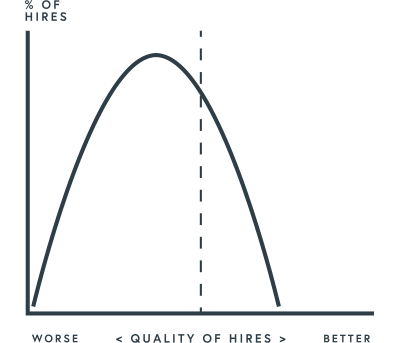C3S3: Visualizing Success
To wrap up the final chapter of this Guide, we wanted to provide you with a quick way to visualize the potential of this process—especially if you may be thinking, “this seems like a lot of work for one hire.”
Seeing is Believing
We’ve mentioned Jeff Korzenik and his book, Untapped Talent, a number of times throughout this Guide and for good reason. Over the years, Jeff has talked with hundreds of business people from all over the country and has visualized second chance hiring models based upon their experiences (as hard data is limited or doesn’t exist). The story they tell is fascinating.
Traditional Candidate Only Model
Businesses who only hire traditional employees tend to see average results in their performance quality. Some employees perform better or worse than others, with most being somewhere in the middle.
Disposable Employee Model
Businesses who utilize second chance hiring in addition to traditional, but do not invest in thorough candidate selection and proper support tend to see second chance hires perform worse than traditional ones.
Undifferentiated Model
Business who are selective with their second chance hires, but don’t invest in the proper support for them tend to see mixed results. Worse performance is just as likely as better performance in second chance hires.
True Second Chance Model
Businesses who are selective with their second chance hires and invest in properly supporting them tend to see better performance. As Jeff notes, “These are hires who more than repay the investment in adopting this model. They offer employers high engagement, low turnover, and strong productivity.”
A Holistic Combination
When businesses are able to effectively evaluate candidates with criminal records who are ready for employment and invest in supporting them, better than average hires can result. It’s this holistic combination of thoughtful evaluation and support that fuels our entire Employment Partnership process.
*Note: All charts by Jeff Korzenik. Used with permission.




